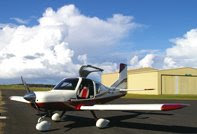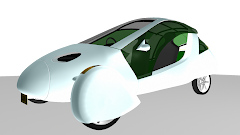I received a call from Wall at Bert Floods, (Bert Flood Imports sell and support the Rotax range of aircraft engines and have done so since we began manufacturing back in 1985, Bert passed away last friday after a long illness, this is sad news, Bert was a pioneer in light sport aviation and his crackly voice and cheeky grin will be missed, he has (as we have) established a sound family based business that should carry on, we wish his family all the best through this sad time.
We are all v'excited to be in the early stages of negotiations with a prospective agent for our aircraft in S-Africa, watch this space !!
Climate change, love it or hate it, believe it or distrust it, it isn't going to go away any time soon and I believe that if you/me/us// all dont become a part of the green revolution, we will be consumed by it, you can quote me on that.
I have personally read a few books (Hot Flat and Crowded" being the most recent) and visited a few cities where the air is so bad that you could cut it up into chunks and sell it as sludge !! so I have come to the conclusion that its time we did something about it. If we don't, we are simply taking too big a risk with our future.
Watch this space for the evolution of the Roadie 2 seat 3 wheel electric car design, to see a similar motor vehicle, go to www.aptera.com to see what they are doing in the USA in this area or T-Rex in Canada or Aero-3S in Qubeck.
Agreed, the contribution I or my company can make is minuscule compared to China's (even slower) industrial expansion but then, if we all used that as an excuse for inaction, the problem will only continue to get worse. Just like a turbine blade only gives the air inside the engine a little wak, many blades and many little waks add up to 20,000 hp coming out the engines tail pipe, hell, this is a real bad analogy, one trip in a 747 to Europe, consumes 1 cubic kilometer of ther earths atmosphere, consumes it, converts it to 500 tons of carbon and dumps it in the upper atmosphere........... oh well !
So my contribution..................The LightWing range use what is called a "cradle to cradle" recycling philosophy, that is to say that when the aircraft is all used up, it can enjoy the maximum in recycling, the steel fuselage is 100% recyclable while the fiberglass shell (less than 20 kg total) is the only item that can not be easily recycled, aluminum wings can be totally recycled.
This means that about 80% of the airframe can be recycled compared to only 10% of an all composite airframe.
Our Variable pitch prop further adds to in-flight efficiency in all our aircraft particularly the low wein SP-200, by maximizing the thrust vrs. speed of the aircraft, a fixed pitch prop wall always be a copmromise, with our VIP prop, you throttle back to lets say 4,900 engine RPM (Rotax) and bring the fuel consumption back to less than 15 l per hour, this means less CO2 emission and a better environmental outcome while you can still cruise at over 100 kts. I dont know exaclty how this equates to gms of CO2 per kilometer but I have a feeling I soon will, CO2 output will become more and more important in the future.
Now I dont want the readed to think that LightWing habitually goes about biting off more than we can chew BUT........... we are building a lightweight motor vehicle.
I believe that time spent on this project will have usefull spinoffs in our aviation persuits.
For example, the body shell of the 3 wheel all electric Roadie will find an application as a body for a rear engine pusher aircraft and the Roadie will have the option of throwing a couple of pins, un-coupling the power train and fitting wings for the ultimate fly away car or for that matter, floats for a high speed boat or amphib aircraft, is that a flexible environmentally friendly approach or what ? The same 2 seat body is able to fulfill a number of rolls so no need for 3 different vehicles AND in all rolls, the common body is super light weight and therfore energy efficient.
Some history.............
I see a number of similarities in the way the aircraft industry was twenty-three years ago, and how the automotive industry is today.
Twenty-three years ago there were rules in place that prohibited light aircraft from flying above 500ft altitude and prohibited flying over or crossing public roads (remember this was ten years after we landed on the moon). The sport aircraft industry, that back then was a joke, employed no more than 2 or 3 staff, now employs hundreds and the industry exports more than it imports.
The same applies to the car industry today.
There are rules that limit innovative automobile design to home builders that are currently converting small cars to battery power at the lower end and at the other extreme, major manufacturers do not seem to be doing anything that makes them eligible for the billions promised under this new green scheme.
Twenty-three years ago most Civil Aviation staff were against the light aircraft industry and did everything they could to stop it. Those people are gone now, replaced by and industry that is both safer and largely self-regulated.
I believe innovation will come mostly from grass roots companies and this is where the majority of the funding should be applied. The larger companies will continue to manufacture larger vehicles but I believe, particularly in the USA and Australia, they will go the way that aircraft manufacturers have gone- they will not change. If they wanted to go green, they would have started, as they have in Europe, long before now.
What happened over the past fifty years in aviation is exactly the same as has happened in the auto industry. When an accident occurred, a new rule was made in an effort to prevent the same accident occurring again. This made the rule book grow and it also made the aircraft heavier and more complex to the point that almost no one was prepared to make aircraft anymore. Innovation had been killed! Efficiency has also been a casuatly. My new generation sports aircraft weighs 300 kg and can easily carry its own weight. Thats one to one in efficiency. A 1.5 tonne motor vechicle is lucky to have 1/10th of this carrying capacity.
What brought about the revolution in design and certification of aircraft CAN and MUST be applied to motor vehicles.
Any Time Now.
Monday, February 2, 2009
Subscribe to:
Post Comments (Atom)



No comments:
Post a Comment